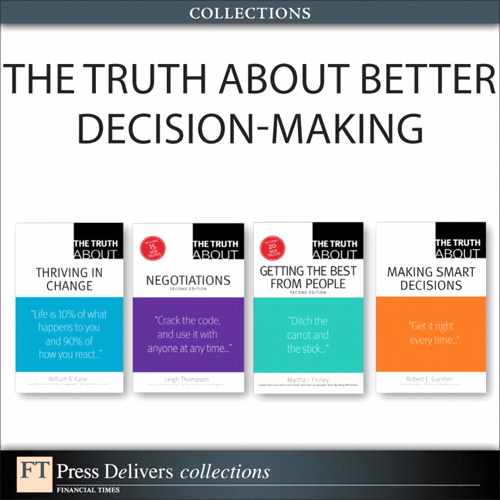Truth 23. Organizational structure: Look in from the outside
Whether it's one person with a Rolodex or a group of entrepreneurs in a garage, organizations in their infancy tend to be "open" environments—free of formal policy and procedure, with process-mapping and decision making being drafted on the back of an envelope.
Then, a funny thing happens. As an organization grows, its needs change. Before you know it, formal discussions are taking place about employee manuals, job levels, who can sign for what, and who gets what office furniture.
Of most importance for an expanding organization or one facing "better, faster, and cheaper" challenges are the choices to be made about the formal structure of the organization.
The structure of an organization is a derivative of economic and operational synergy—aligning the organization's vision; product; and operating, technological, and delivery capabilities with its primary stakeholders. Strategically, organizations—especially larger ones, are generally segmented, in whole or part, by function, product or service, matrix (a combination of functional and product or service), geography, outsourced resources, shared services, and project teams (teams dedicated to specific needs and deployed on a short-term basis as needed).
Decisions involving structure are important. Absent related discipline and protocol, the organization will suffer from ineffectiveness and inefficiencies. Unforeseen impediments, obstacles, bureaucracies, egos, "groupthink," or other restrictions will smother creativity, productivity, and enthusiasm.
Recognizing that there is no "cookie cutter" template for all organizations—given their unique natures and cultures, how then do you determine the ideal structure? The answer is fourfold:
1. Involve the right people—those closest to the work at all levels— This is critical, for it gives all participants the chance to put their personal stamp on the operation. This will, by extension, play an important role in changing the organization's culture and operating environment, and it will enhance the probability for the success of implementation.
2. Contrary to the most common approach taken to address business challenges, you should start with a "blank slate" and look at the organizational structure from the "outside in," with the mindset of becoming your toughest competitor— This requires an analysis of key strategic relationships; lines of business; common functions; shared services; customer responsiveness; and local/national/regional/global business requirements—with an outsider's objective perspective.
You should start with a "blank slate" and look at the organizational structure from the "outside in."
One of the world's largest appliance manufacturers recognized that its overall operating structure was a major contributor to its increasing red ink. In response, the CEO formed an internal six-person committee, comprised of a cross section of international and functional expertise, and charged them with researching, analyzing, and recommending a new blueprint for the way the company would operate and approach the market. This was a complex and demanding task as this company had more than 100,000 employees with operations in over 50 countries and more than 500 product lines.
For the better part of the next six months, the committee urgently gathered relevant information from two sources. Internally, they visited various facilities all over the world to gain sharper insight about the company's assets and limitations. In parallel, and with far greater emphasis and attention, they were also globetrotting to the headquarters of several other Fortune 100 companies to study their organizational structures and the rationale for each—attempting to synthesize "best practices," as well as their potential competitive application. They were also speaking to customers of all sizes.
Ultimately, the committee's "outside in" findings led to a corporate-wide organizational restructuring, focusing upon breaking up the "silos" of divisions, groups, regions, and countries. Operational and reporting changes included the consolidation of global product lines, leveraging the operational and distribution synergies, the formation of strategic partnerships, the outsourcing of competencies that were not considered as "core," the elimination of redundancy, expanded spans of control, and centralization and sharing of common resources and services. First-year financial savings were in the hundreds of millions of dollars.
3. You need to have some concurrent debate and reach consensus about the characteristics of the new organization— Words like nimble, streamlined, flat, product/market/customer driven, and entrepreneurial will likely be bantered about. This discussion will also determine where the appropriate level is to assign authority and accountability. Specifically, how willing are you to share decision making, leadership, project planning, conflict management, and rewards?
The answers to these questions ultimately reflect how empowerment is practiced in your organization. Generally speaking, research has shown that empowered organizations tend to have fewer management layers with broad spans of control and local profit and loss responsibility; they have a small, facilitative head office with shared power and risk-taking; and they have a process-based structure that inhibits silos and functional kingdoms.
4. Remember that you have a variety of subsequent staffing options available to you— These include populating and supporting your organization with some combination of full-time employees, part-time employees, retained opinion leaders, on-demand consultants, contractors, and professional services providers.
Chances are that that you'll staff your team with full-time employees to handle the valley of workload and rely on contingency resources for the peaks.
In sum, change presents a wonderful opportunity to look at your organizational structure. Whether you're starting from scratch or you're a participant in a long-standing hierarchy, you should consider and identify a framework that ensures the maximum probability for the execution and attainment of your vision. Get lots of adhesive tape and index cards, and be creative. You will likely generate organizational pride, a collaborative spirit, and open minds.
